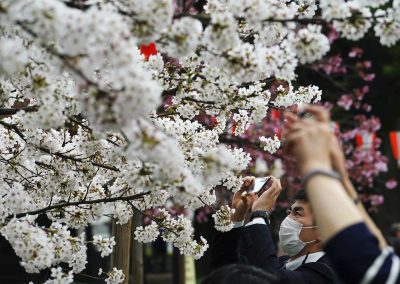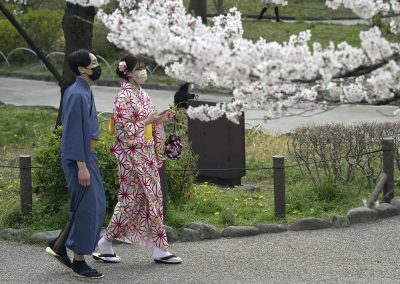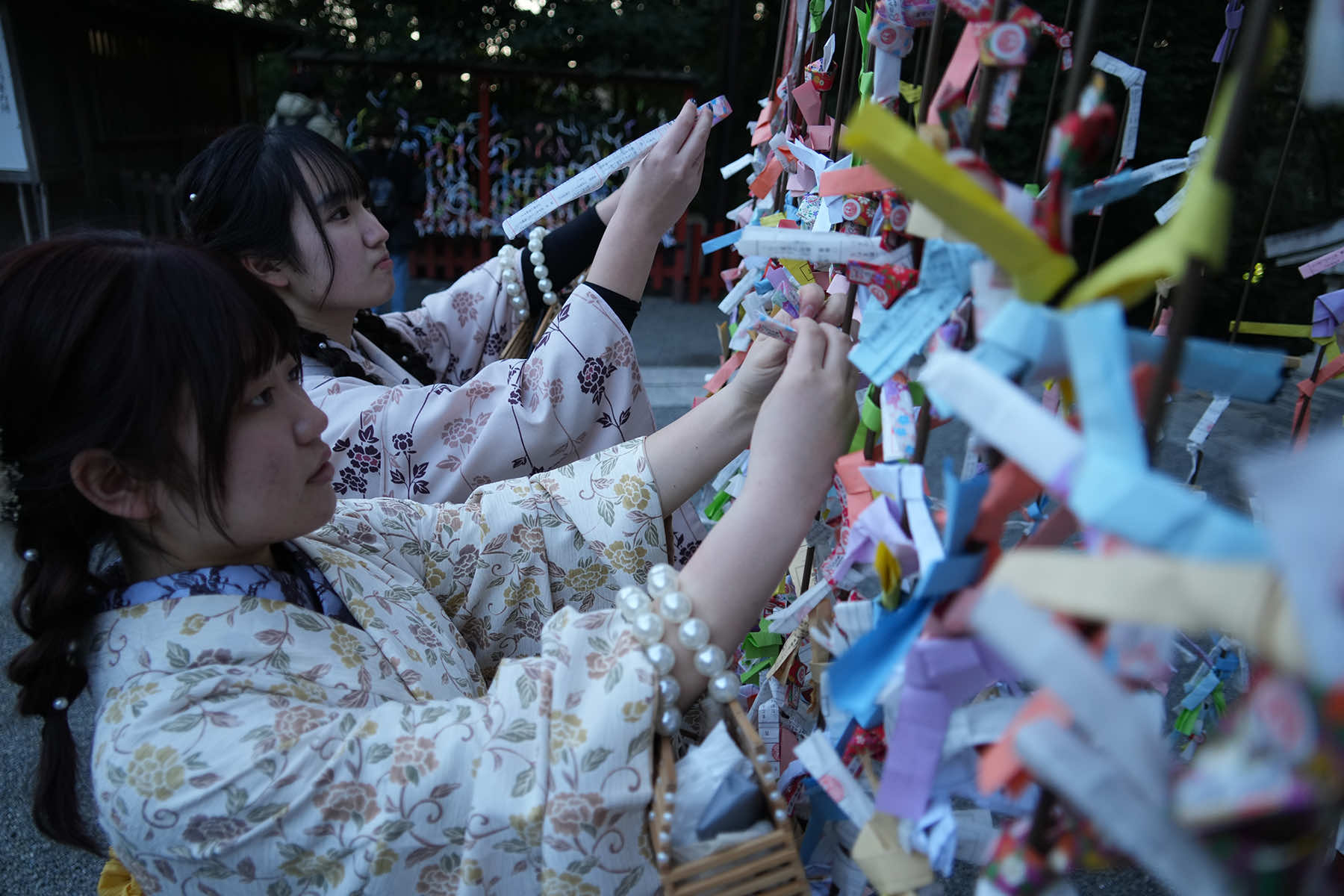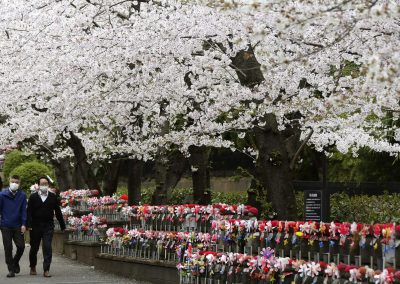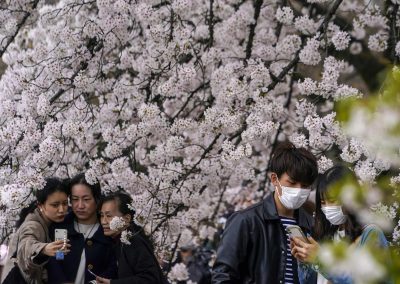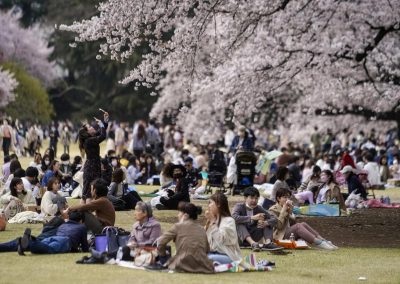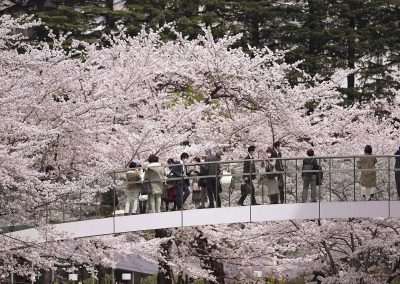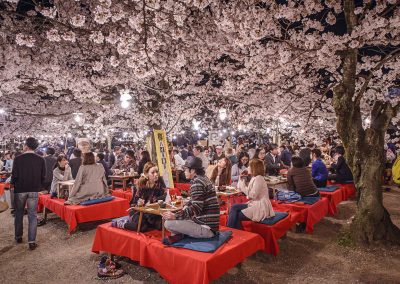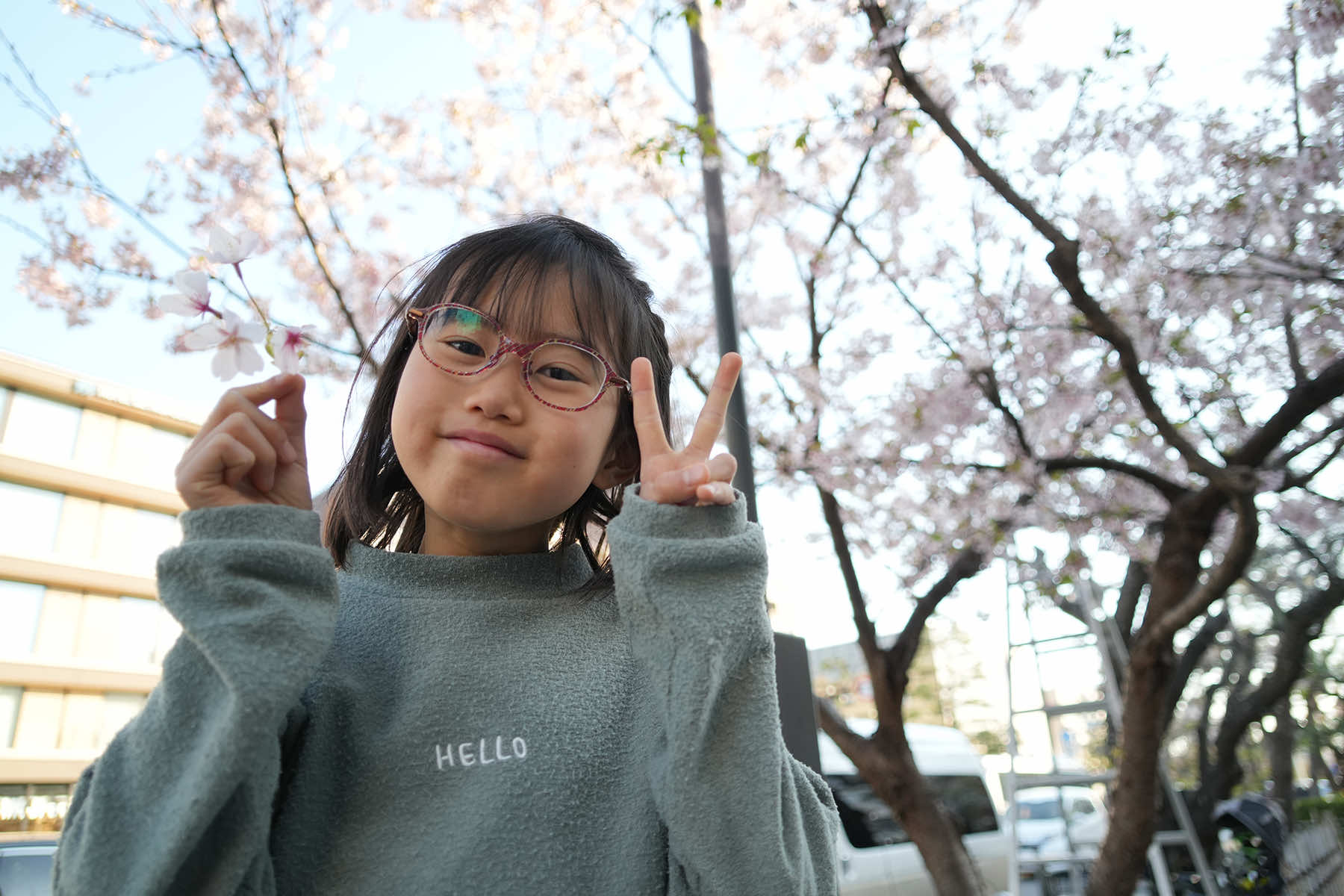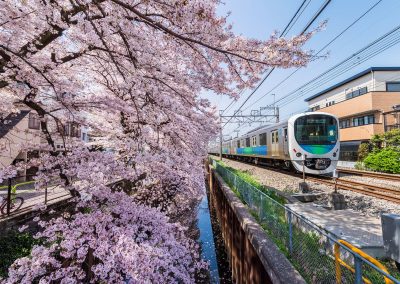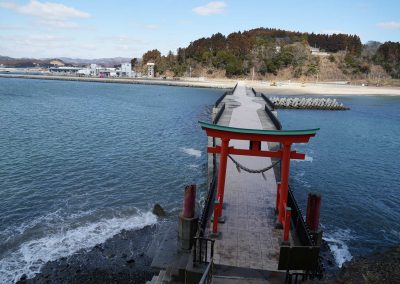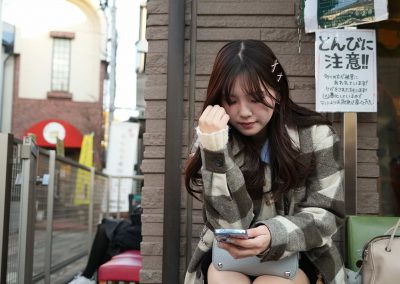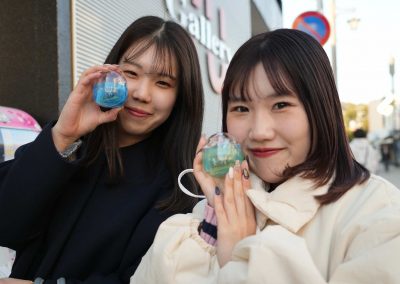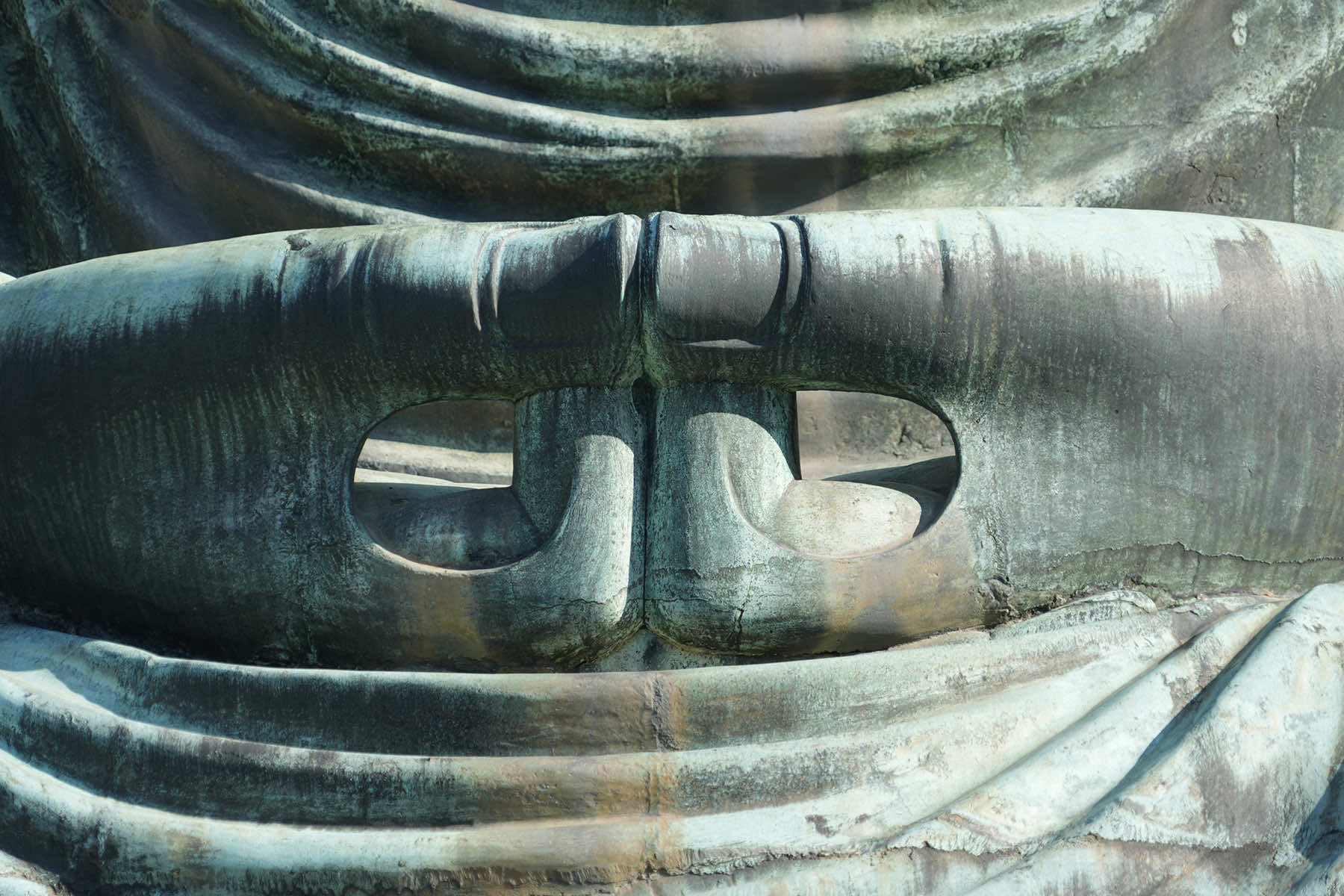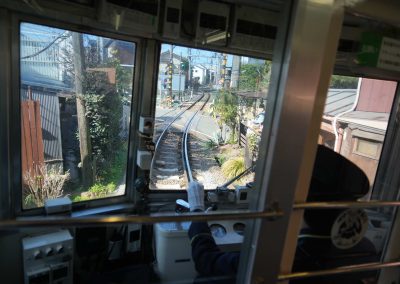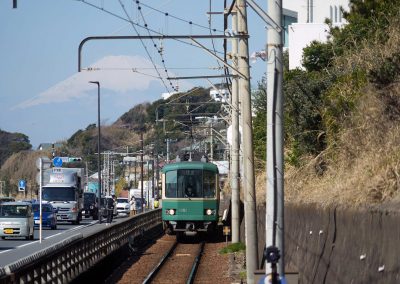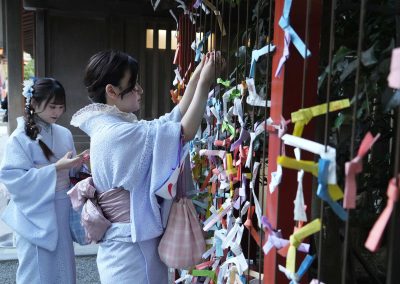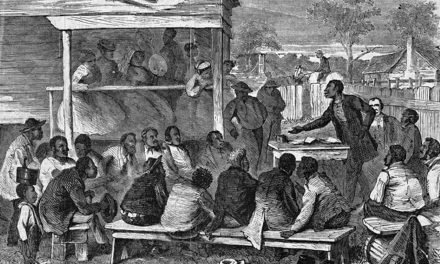
They are symbols of the transience of beauty and the return of spring, and their appearance is an excuse for nationwide picnicking, drinking, and leaving work at lunchtime.
But the future of Japan’s famous cherry blossoms is in jeopardy as man-made global warming forces the delicate flowers to open unnaturally early, and threatens to nip them in the bud altogether.
Trends are carefully documented by Japanese scientists. In Tokyo, the cherry blossoms – known in Japanese as Sakura – made history last year by appearing on March 14, marking the earliest bloom recorded. Predictions indicate that the blossoms would emerge a week earlier in 2024 than the historical average, highlighting a troubling trend.
Between 1990 and 2020 the average day of blooming was five days earlier in Tokyo and Osaka, and six days earlier in Nagoya and Hiroshima, compared with the preceding three decades. The unpredictability of the flower season is causing dismay among businesses that rely on cherry blossoms to provide their earnings.
Brewers and department stores scramble to get cherry blossom-themed cans of beer, bottles of sake, and lunch boxes out into the shops in time, and travel agencies face mass cancellations of flower-viewing tours scheduled to take place after the last petals have fallen.
Japan’s cultural identity is deeply intertwined with the changing seasons, celebrated through various festivals and events throughout the year.
Throughout Japanese history, the passing of the seasons has been a theme of art, literature, and cuisine, and the cycles of Japanese businesses are based around a series of annual festivals, from the May “Golden Week” break through the summer holiday season, the New Year and the ten-day blooming of the cherry blossoms.
But global warming is upsetting this well-established schedule. Average temperatures across Japan have risen 2.34 degrees Fahrenheit over the last century. In Tokyo a “heat island” effect, caused by the density of tall buildings and lack of green spaces and water surfaces, has driven temperatures up by 5.94 degrees Fahrenheit.
Winter resorts have reported shortages of snow, and increasing numbers of bears have been marauding in towns because warm weather has withered the nuts and plants they rely on to fatten up for hibernation. And decade by decade the sakura, or cherry trees, are putting forward their famously beautiful, delicate pink flowers earlier and earlier.
Since 1963, according to the Japan Meteorological Agency (JMA), the average date of blooming has arrived earlier by 1.2 days every ten years — since 2020, and especially in Tokyo, the trend has become more pronounced than ever.
For 2024, JMA declared the official start of sakura season on March 29, after an employee observed more than five to six blossoms on the Somei Yoshino sample tree. That made the start date almost two weeks later than the initial forecast, five days later than the average, and a whopping 15 days later than last year.
Cherry blossom prediction is a serious business. Japanese newspapers carry maps depicting the likely progress of the “cherry blossom front.” The blooms occur over several weeks and moves across the archipelago from warmer and more sheltered southern regions to the cooler north.
For those fleeting ten days, parks all over Tokyo are packed with office workers, eating, drinking, and singing beneath the trees. At the peak of their flowering millions of people every day indulge in the ritual known as hanami, or “flower viewing.”
Tourists, foreign and Japanese, converge on famous blossom-viewing spots at the moment when they are expected to be at their fullest.
In the past, this happened in Tokyo at the end of March and the beginning of April when corporate Japan breathed a sigh of relief after the closing of accounts at the end of the financial year. But this is now more difficult to plan for in recent years.
Hanami parties were canceled in 2023 in the city of Koriyama because they were too late, and tour companies canceled bus tours to the Takizakura, a famously beautiful tree in Fukushima, after it shed its petals early.
Scientists warn that if global warming continues, the flowers could start appearing later, rather than sooner, or fail altogether. “We might conclude that the start date will be earlier and earlier, but it’s not that simple,” Daisuke Sasano, of the JMA, said.
Experts warn that if global warming continues unabated, the timing of cherry blossom seasons could become even more erratic, potentially leading to later blooms or preventing the trees from flowering altogether.
3.11 Exploring Fukushima
- Journey to Japan: A photojournalist’s diary from the ruins of Tōhoku 13 years later
- Timeline of Tragedy: A look back at the long struggle since Fukushima's 2011 triple disaster
- New Year's Aftershock: Memories of Fukushima fuels concern for recovery in Noto Peninsula
- Lessons for future generations: Memorial Museum in Futaba marks 13 years since 3.11 Disaster
- In Silence and Solidarity: Japan Remembers the thousands lost to earthquake and tsunami in 2011
- Fukushima's Legacy: Condition of melted nuclear reactors still unclear 13 years after disaster
- Seafood Safety: Profits surge as Japanese consumers rally behind Fukushima's fishing industry
- Radioactive Waste: IAEA confirms water discharge from ruined nuclear plant meets safety standards
- Technical Hurdles for TEPCO: Critics question 2051 deadline for decommissioning Fukushima
- In the shadow of silence: Exploring Fukushima's abandoned lands that remain frozen in time
- Spiral Staircase of Life: Tōhoku museums preserve echoes of March 11 for future generations
- Retracing Our Steps: A review of the project that documented nuclear refugees returning home
- Noriko Abe: Continuing a family legacy of hospitality to guide Minamisanriku's recovery
- Voices of Kataribe: Storytellers share personal accounts of earthquake and tsunami in Tōhoku
- Moai of Minamisanriku: How a bond with Chile forged a learning hub for disaster preparedness
- Focus on the Future: Futaba Project aims to rebuild dreams and repopulate its community
- Junko Yagi: Pioneering a grassroots revival of local businesses in rural Onagawa
- Diving into darkness: The story of Yasuo Takamatsu's search for his missing wife
- Solace and Sake: Chūson-ji Temple and Sekinoichi Shuzo share centuries of tradition in Iwate
- Heartbeat of Miyagi: Community center offers space to engage with Sendai's unyielding spirit
- Unseen Scars: Survivors in Tōhoku reflect on more than a decade of trauma, recovery, and hope
- Running into history: The day Milwaukee Independent stumbled upon a marathon in Tokyo
- Roman Kashpur: Ukrainian war hero conquers Tokyo Marathon 2024 with prosthetic leg
- From Rails to Roads: BRT offers flexible transit solutions for disaster-struck communities
- From Snow to Sakura: Japan’s cherry blossom season feels economic impact of climate change
- Potholes on the Manga Road: Ishinomaki and Kamakura navigate the challenges of anime tourism
- The Ako Incident: Honoring the 47 Ronin’s legendary samurai loyalty at Sengakuji Temple
- "Shōgun" Reimagined: Ambitious TV series updates epic historical drama about feudal Japan
- Enchanting Hollywood: Japanese cinema celebrates Oscar wins by Hayao Miyazaki and Godzilla
- Toxic Tourists: Geisha District in Kyoto cracks down on over-zealous visitors with new rules
- Medieval Healing: "The Tale of Genji" offers insight into mysteries of Japanese medicine
- Aesthetic of Wabi-Sabi: Finding beauty and harmony in the unfinished and imperfect
- Riken Yamamoto: Japanese architect wins Pritzker Prize for community-centric designs
MI Staff (Japan)
Lее Mаtz
Eugene Hoshiko (AP), Koji Sasahara (AP), Kichiro Sato (AP), and Aaronchen, Abel Tumik, Akarawut, luehand, Crazypharm, Elena Berd, Frentan, Hit1912, Jiratto, Kae B. Yuki, Lucas Shu, Norikazu, Picture Cells, Sakarin Sawasdinaka, Sean Pavone, Sergii Rudiuk, Shawn CF, Substance T. Productions, Travel Pixs, Yury Zap (via Shutterstock)
3.11 Exploring Fukushima: The Tōhoku region of Japan experienced one of the worst natural disasters ever recorded when a powerful earthquake was followed by a massive tsunami, and triggered an unprecedented nuclear crisis in 2011. With a personal connection to the tragedies, Milwaukee Independent returned for the first time in 13 years to attend events commemorating the March 11 anniversary. The purpose of the journalism project included interviews with survivors about their challenges over the past decade, reviews of rebuilt cities that had been washed away by the ocean, and visits to newly opened areas that had been left barren by radiation. This special editorial series offers a detailed look at a situation that will continue to have a daily global impact for generations. mkeind.com/exploringfukushima









